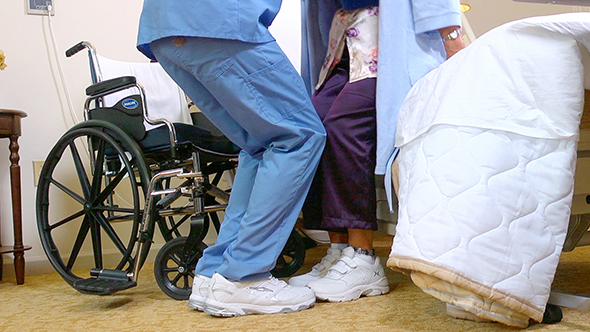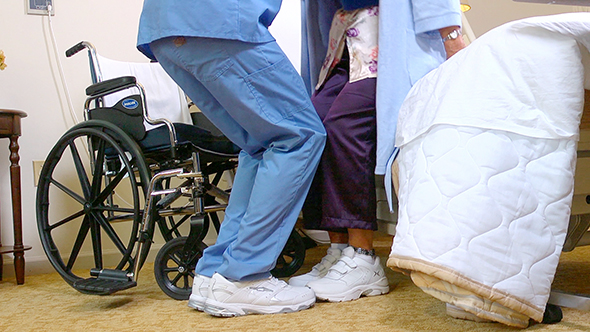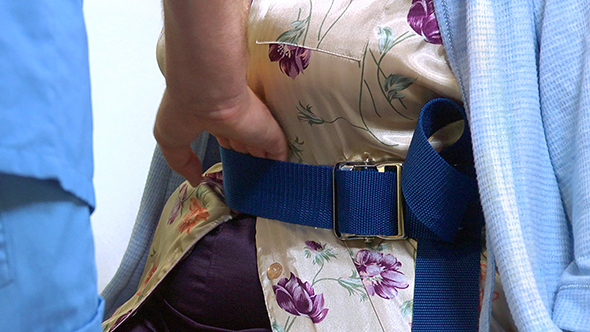Body Mechanics and Exercise
Select a Skill:
- » Moving the Person Up in Bed
- » Positioning the Person in Bed
- » Transferring the Person to a Chair or Wheelchair
- » Moving the Person to a Stretcher
- » Transferring the Person Using a Mechanical Lift
- » Assisting with Range-of-Motion Exercises
- » Helping the Person Walk
Take the Review Test:

Purpose

- Patients and residents are moved to and from beds, chairs, wheelchairs, shower chairs, commodes, toilets, and stretchers.
- The amount of help needed and the method used vary with the person’s dependency level.
- A transfer (gait) belt is used to support persons during transfers, reposition them in chairs and wheelchairs, and ensure safety when walking.
- Safety is important for chair, wheelchair, and other transfers. Help the person out of bed on his or her strong side. In transferring, the strong side moves first and pulls the weaker side along. Transfers from the weak side are awkward and unsafe.
- Use stand-and-pivot transfers if:
- The person’s legs are strong enough to bear some or all of his or her weight.
- The person is cooperative and can follow directions.
- The person can assist with the transfer.
Equipment
Roll cursor over items to see labels. For the purposes of clearly depicting the equipment, a barrier is not shown in this photo. When providing care, a barrier should always be placed on the surface before placing the equipment.

Wheelchair or arm chair
Lap blanket
Bath blanket
Robe
Paper or sheet
Transfer belt, if needed
Non-skid footwear
Seat cushion, if needed
Delegation
Follow delegation guidelines. Before transferring a person to a chair or wheelchair, obtain this information from the nurse and care plan:
- What procedure to use
- The person’s dependency level
- The amount of help the person needs
- What equipment to use
- The person’s height and weight
- The number of staff needed
- Areas of weakness
- What observations to report and record
- When to report observations
- What patient or resident concerns to report at once
Preparation

- Observe quality-of-life measures.
- Review the information under Delegation and Safety and Comfort.
- Collect the equipment.
- Practice hand hygiene.
- Identify the person. Check the ID bracelet against the assignment sheet. Also call the person by name.
- Provide for privacy.
- Decide which side of the bed to use. Move furniture for a safe transfer.
Safety

- To help prevent falls, have the person wear non-skid footwear for transfers and tie shoelaces securely. Also avoid long gowns, long robes, and robes with long ties.
- Lock bed and wheelchair wheels and wheels on other devices for a safe transfer. Afterwards, unlock the wheels to position a wheelchair as the person prefers. After positioning it, lock the wheels or keep them unlocked according to the care plan.
- To use a transfer belt, follow manufacturer’s instructions and these safety measures:
- Position the belt buckle where the person cannot reach and release it.
- Check for snugness by sliding an open, flat hand under the belt.
- Do not leave excess strap dangling. Tuck it into the belt.
- Grasp the belt from underneath. If it has handles, grasp it by the handles.
- Remove the belt after the procedure. Do not leave the person alone while he or she is wearing the belt.
- The chair, wheelchair, or other device must support the person’s weight.
- The number of staff needed depends on the person’s abilities, condition, and size.
- To prevent injuries, the person must not put his or her arms around your neck.
- If not using a mechanical lift, use a transfer belt for chair or wheelchair transfers. Only if instructed by the nurse and the care plan, perform the transfer putting your arms around the person and grasping the shoulder blades.
Comfort
- After the transfer, position the person in good alignment. Place needed items within reach.
- Always apply a transfer belt over clothing. Apply it under the breasts. Never position the belt buckle over the person’s spine.
- If the nurse allows, cover the vinyl back and seat of a wheelchair or bedside chair with a folded bath blanket.
- Ask the nurse how to use and place a wheelchair cushion or positioning device, if used. Also follow manufacturer’s instructions.
Procedure Video
Audio Description: OFFFollow-up Care

- Provide for comfort.
- Place the call light and other needed items within reach.
- Unscreen the person.
- Complete a safety check of the room.
- Practice hand hygiene.
- Follow the correct procedure to return the person to bed.
Reporting/Recording
Report and record your observations, including:
- Pulse rate before and after the transfer
- Complaints of dizziness, pain, discomfort, difficulty breathing, weakness, or fatigue
- The amount of help needed to transfer the person
- Who helped you with the procedure
- How the person helped with the transfer
- How you positioned the person.
Review Questions
Select the best answer.
1. What is the purpose of using a transfer (gait) belt?
 To meet state and federal requirements
To meet state and federal requirements To prevent skin tears
To prevent skin tears To avoid the need for mechanical lifts
To avoid the need for mechanical lifts To support persons during transfers
To support persons during transfers
Select the best answer.
2. Before transferring a person from the bed to a wheelchair, which step should you take?
 Position the wheelchair next to the bed on the person’s weak side
Position the wheelchair next to the bed on the person’s weak side Place the chair directly across from the bed so that one or two steps are taken
Place the chair directly across from the bed so that one or two steps are taken Position the wheelchair near the bed on the person’s strong side
Position the wheelchair near the bed on the person’s strong side Place the wheelchair at the foot of the bed at a 90-degree angle to the bed
Place the wheelchair at the foot of the bed at a 90-degree angle to the bed
Select the best answer.
3. What is the correct way to apply a transfer belt?
 Apply the belt under the person’s clothing to avoid skin injuries
Apply the belt under the person’s clothing to avoid skin injuries Make sure that the belt is under the person’s breasts
Make sure that the belt is under the person’s breasts Place the belt snugly around the person’s chest under the arms
Place the belt snugly around the person’s chest under the arms Tighten the belt around the person’s hips over clothing
Tighten the belt around the person’s hips over clothing
Select the best answer.
4. When may you transfer the person from the bed to a chair without a transfer belt?
 When a transfer belt is not available
When a transfer belt is not available When a coworker assists with the person’s transfer
When a coworker assists with the person’s transfer When the chair faces the head of the bed
When the chair faces the head of the bed When directed by the nurse and the care plan
When directed by the nurse and the care plan
Select the best answer.
5. During a transfer, where should you grasp the transfer belt?
 At each side from underneath
At each side from underneath At the handles from above
At the handles from above At the front from above
At the front from above At the back from underneath
At the back from underneath
You have completed the Review Questions for this skill. To take the Review again select the Start Over button. To proceed to another skill select from the dropdown menu. Select the Home or Back button to proceed to the next section.

